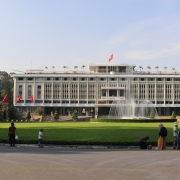What is the main purpose of ASEAN?
Topic of Study [For H2 History Students]:
Paper 2: Regional Conflicts and Co-operation
Source Based Case Study
Theme III Chapter 1: Reasons for the formation of ASEAN
Topic of Study [For H1 History Students]:
Essay Questions
Theme II Chapter 2: The Cold War and Southeast Asia (1945-1991): ASEAN and the Cold War (ASEAN’s responses to Cold War bipolarity)
The tumultuous sixties: Why was ASEAN formed?
The Association of Southeast Asian Nations (ASEAN) was established as a regional organisation on 8 August 1967 by five members – Singapore, Malaysia, Thailand, the Philippines and Indonesia.
The regional grouping was formed during a troubling decade in which Southeast Asian governments were pre-occupied with domestic challenges, such as the rise of Communist insurgencies.
Let’s take a look at the Bangkok Declaration that was signed by the five members:
SECOND, that the aims and purposes of the Association shall be:
1. To accelerate the economic growth, social progress and cultural development in the region through joint endeavours in the spirit of equality and partnership in order to strengthen the foundation for a prosperous and peaceful community of South-East Asian Nations;
2. To promote regional peace and stability through abiding respect for justice and the rule of law in the relationship among countries of the region and adherence to the principles of the United Nations Charter;
An excerpt from the ASEAN Declaration (Bangkok Declaration), 8 August 1967.
In order to understand the purpose of ASEAN, it is imperative to consider the motivations of individual member states.
Singapore: Economics and Regional Security
For Singapore, ASEAN was a necessary grouping to address the immediate concerns of the government. On 9 August 1945, the leaders of an ‘accidental nation’ had to contend with the limited resources in Singapore. On 18 July 1967, the British announced its plans to withdraw from the East of Suez. The unexpected departure of the British forces left Singapore vulnerable to security threats.
As one of the founding fathers of ASEAN, Mr Rajaratnam played a pivotal role in fostering an ASEAN consensus and promoting a more cohesive and cooperative region. Initially, he argued that regional cooperation should be contemplated primarily in economic terms.
… Mr Rajaratnam articulated Singapore’s view that ASEAN was primarily an organisation for promoting economic cooperation and not for resolving the region’s military and security problems.
An excerpt from “S Rajaratnam on Singapore: From Ideas to Reality” by Chong Guan Kwa, S. Rajaratnam.
However, not all members were supportive of the reliance on external powers for regional security, such as Indonesia.
Indonesia: Regional leadership in a post-Konfrontasi era
The former President Sukarno’s policy of Confrontation had strained diplomatic relations with neighbouring countries like Malaysia and Singapore. Subsequently, Suharto supported the formation of ASEAN not only to mend relations but also strive to assume a leadership position in the grouping.
Nevertheless, Suharto still held a common view with his predecessor in pursuing a policy of non-alignment.
In effect, the policy of konfrontasi prevented Indonesia from winning recognition as a regional leader in Southeast Asia and beyond in the non-aligned movement. Later, President Suharto would argue that Sukarno’s konfrontasi had also violated Indonesia’s bebas-aktif principle in foreign affairs, whereby Jakarta was to pursue an independent and active foreign policy, which implied avoiding an alignment with any one bloc.
An excerpt from “ASEAN’s Diplomatic and Security Culture: Origins, Development and Prospects” by Jurgen Haacke.
On 16 August 1966, Tun Razak and Adam Malik signed the Jakarta Agreement that signified the official end to the Confrontation. The Agreement was built on the basis on an earlier Bangkok Accord that required Indonesia to recognise Malaysia diplomatically. Malaysian-Indonesian relations were eventually normalised on 31 August 1967, a few weeks after ASEAN was established.
Regional cooperation was firstly intended to exorcize the ghost of confrontation, to provide a contrast between Sukarno’s confrontative foreign policy and the New Order’s more conciliatory approach.
… Nevertheless, the urgency for Indonesia to co-found ASEAN was primarily to restore the country’s regional and international standing.
An excerpt from “Indonesia in ASEAN: Foreign Policy and Regionalism” by Dewi Fortuna Anwar.
The relevance of ASEAN in the post-Cold War era
Although some critics point out that ASEAN has yet to resolve the South China Sea dispute, many recognise ASEAN’s successes in contributing to the creation of a peaceful and stable region. In 2017, ASEAN celebrated its fiftieth anniversary. Moving forward, member nations have reaffirmed their commitment in advancing regional cooperation.
What can we learn from this article?
Consider the following question:
– Assess the view that the ASEAN was formed as a result of economic reasons.
Join our JC History Tuition and learn more about the regional organisation. The H2 and H1 History Tuition feature online discussion and writing practices to enhance your knowledge application skills. Get useful study notes and clarify your doubts on the subject with the tutor. You can also follow our Telegram Channel to get useful updates.
We have other JC tuition classes, such as JC Math Tuition and JC Chemistry Tuition. For Secondary Tuition, we provide Secondary English Tuition, Secondary Math tuition, Secondary Chemistry Tuition, Social Studies Tuition, Geography, History Tuition and Secondary Economics Tuition. For Primary Tuition, we have Primary English, Math and Science Tuition. Call 9658 5789 to find out more.











